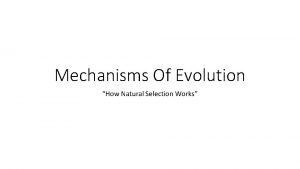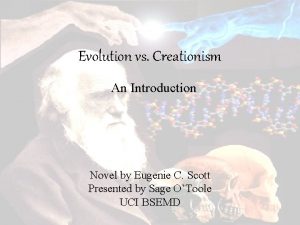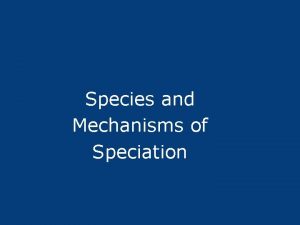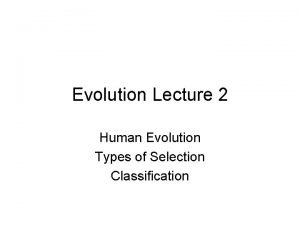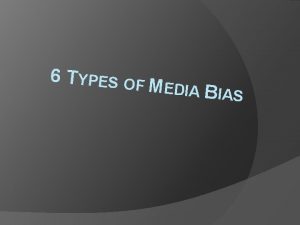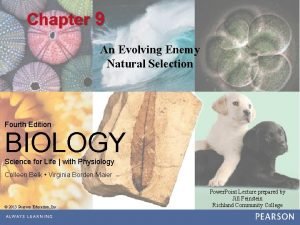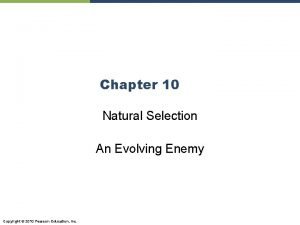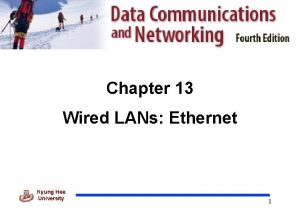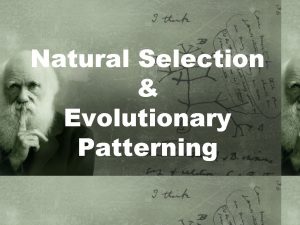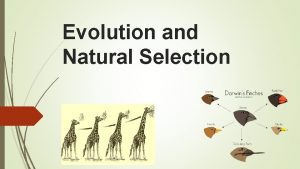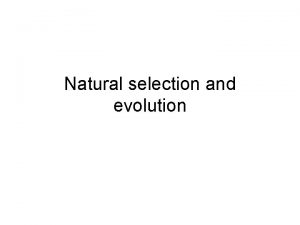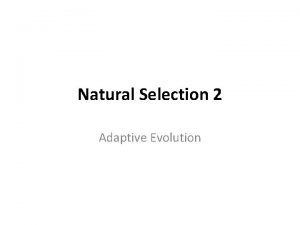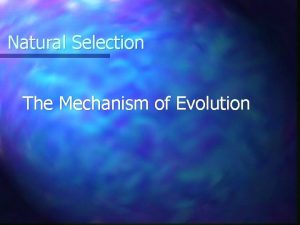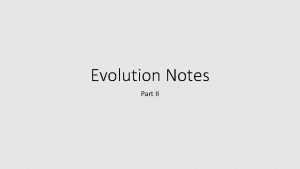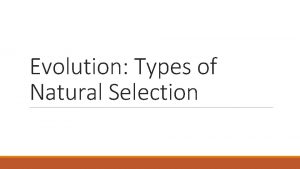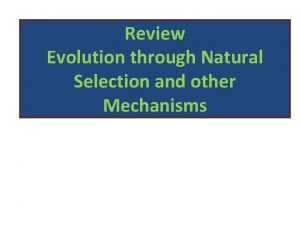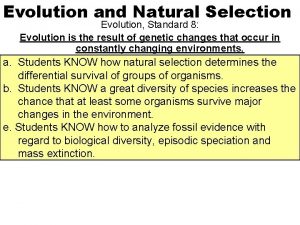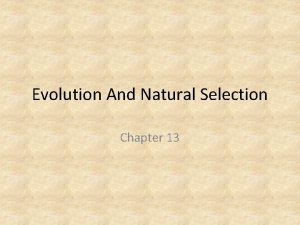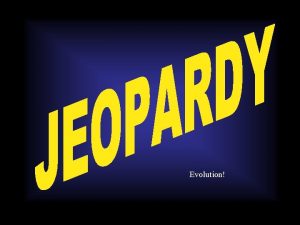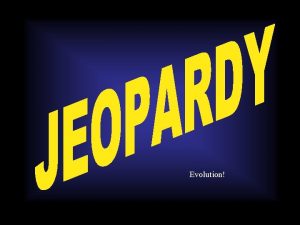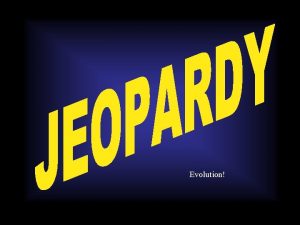Unit 5 Evolution through Natural Selection and other


























- Slides: 26

Unit 5: Evolution through Natural Selection and other Mechanisms

Natural Selection • Natural selection is the process by which those heritable traits that make it more likely for an organism to survive and successfully reproduce become more common in a population over successive generations. • It is a key mechanism of evolution.

Genetic variation -Genetic variation is essential for natural selection. -The natural genetic variation within a population of organisms means that some individuals will survive and reproduce more successfully than others in their current environment.

-Natural selection acts on the phenotype, or the observable characteristics of an organism, but the genetic (heritable) basis of any phenotype which gives a reproductive advantage will become more common in a population. -Over time, this process can result in adaptations that specialize organisms for particular environment.

Sample Question # 1 The idea that evolution takes place at one point in time, followed by a long period without change is ______. A B C D gradualism punctuated equilibrium artificial selection succession From: Test bank 07 -08

Sample Question 2 Charles Darwin proposed his theory of evolution based on observations of nature. Which observation that contributed to his theory is illustrated by this population of beetles? A. Species produce more offspring than can survive. B. Populations remain stable over time. C. Individuals within a population may vary widely. D. Environmental resources are limited.

Genetic Drift -Genetic drift, along with natural selection, mutation, and migration, is one of the basic mechanisms of evolution. -In each generation, some individuals may, just by chance, leave behind a few more descendents (and genes, of course!) than other individuals. The genes of the next generation will be the genes of the “lucky” individuals, not necessarily the healthier or “better” individuals.

Genetic drift affects the genetic makeup of the population but, unlike natural selection, through an entirely random process. So although genetic drift is a mechanism of evolution, it doesn’t work to produce adaptations.

Bottleneck and Founder Effects -Genetic drift can cause big losses of genetic variation for small populations. -Population bottlenecks occur when a population’s size is reduced for at least one generation. -A founder effect occurs when a new colony is started by a few members of the original population.

Sample Question 3 A small population of chimpanzees lives in a habitat that undergoes no changes for a long period. How will genetic drift probably affect this population? A It will accelerate the appearance of new traits. B It will promote the survival of chimpanzees with beneficial traits. C It will increase the number of alleles for specific traits. D It will decrease genetic variation.

Sample Question 4 Genetic drift is a _______ process. A. directed B. selection-driven C. random D. co-evolutionary

Speciation -A species is often defined as a group of individuals that actually or potentially interbreed in nature. In this sense, a species is the biggest gene pool possible under natural conditions. -Speciation is a lineagesplitting event that produces two or more separate species.

Causes of Speciation 1. Geographic Isolation 2. Reduction of Gene Flow

Kinds of Speciation Allopatric speciation is just a fancy name for speciation by geographic isolation Sympatric speciation refers to the formation of two or more descendant species from a single ancestral species all occupying the same geographic location.

Sample Question 5 River This diagram illustrates what kind of speciation? A Sympatric B Allopatric C Geographic D Catastrophic

Cladogram A cladogram is a diagram used to show ancestral relations between organisms, to represent the evolutionary tree of life. These are two identical cladograms.

1 2 3 Analyzing a cladogram… 1. Which species are most closely related? 2. Which is the common ancestor of flies and bees? 3. Which insects share the most recent ancestor?

Here’s a more complicated one… What conclusions can you draw from this ‘tree of life’?

Sample Question 6 According to the cladogram above, which two species are most closely-related? A B C D clubmosses and spikemosses and ferns and flowering plants and clubmosss

Fossil Record Fossils are the preserved remains or traces of animals, plants, and other organisms from the remote past. The totality of fossils, both discovered and undiscovered, and their placement in fossiliferous (fossil-containing) rock formations and sedimentary layers (strata) is known as the fossil record.

• Fossil evidence indicates that over time organisms of increasing complexity appeared on Earth. Bacteria and blue-green bacteria are the first fossils that were preserved from the Precambrian era. • The fossil record contains many examples that could be interpreted to mean that species evolved from more ancient organisms.

Sample Question 7 In a section of the Grand Canyon, scientists have found the fossil remains of several different groups of organisms. The diagram on the left represents the number and age of the fossils the scientists found. The width of each shaded area in the diagram below indicates the relative number of fossils found. Which of the following statements is supported by the fossil record? A B C D Group C is the only group that no longer exists for it’s now extinct. Group B was the most numerous organism 10 million years ago. Group D has been in existence the longest. Group A is the most recent organism to come into existence.

Sample Question 8 Which of the following is usually most helpful in determining the age of the fossils found in rock strata? A the size of the fossils B the color of the fossils C the water content of the rock layer where the fossils were located D the depth of the rock layer where the fossils were found

Sample Question 9 Which of the following best explains how the fossil record provides evidence that evolution has occurred? A It indicates the exact cause of structural and behavioral adaptations of organisms. B It shows that the form and structure of groups of organisms have changed over time. C It shows how the embryos of many different vertebrate species are very similar. D It indicates that forms of life existed on Earth at least 3. 5 billion years ago.

Sample Question 10 Orchids were studied to determine if the amount of humidity affected the flowering of these plants. Which of these was the independent variable in this study? A The percentage of humidity B The length of time required for flowering C The amount watered D The number of flowers on each plant

Remember… INDEPENDENT VARIABLE -is the manipulated variable in the experiment. DEPENDENT VARIABLE -is the variable that is measured at the end of the experiment.
 What is evolution and natural selection
What is evolution and natural selection Types of natural selection in evolution
Types of natural selection in evolution Genetic drift vs gene flow vs natural selection
Genetic drift vs gene flow vs natural selection Natural selection vs evolution
Natural selection vs evolution Similarities
Similarities Natural selection vs artificial selection
Natural selection vs artificial selection Difference between continuous and discontinuous variation
Difference between continuous and discontinuous variation What is stablizing selection
What is stablizing selection Natural selection vs artificial selection
Natural selection vs artificial selection Two way selection and multiway selection
Two way selection and multiway selection Two way selection and multiway selection in c
Two way selection and multiway selection in c Mass selection and pure line selection
Mass selection and pure line selection Speciation definition biology
Speciation definition biology Disadvantages of tangential sawing
Disadvantages of tangential sawing Types of evolution
Types of evolution Examples of bias through selection and omission
Examples of bias through selection and omission Bias by ommission
Bias by ommission Bias through statistics and crowd counts examples
Bias through statistics and crowd counts examples What does bias through selection and omission mean
What does bias through selection and omission mean Bias through selection and omission examples
Bias through selection and omission examples Natural selection and drug resistance
Natural selection and drug resistance Natural selection
Natural selection 5 fingers of evolution
5 fingers of evolution Balancing selection vs stabilizing selection
Balancing selection vs stabilizing selection K selected
K selected K selection r selection
K selection r selection Four generations of ethernet
Four generations of ethernet


